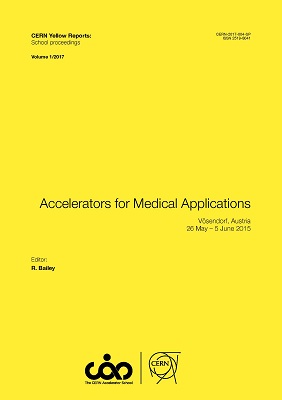Radiobiological Characterization of Clinical Proton and Carbon-Ion Beams
DOI:
https://doi.org/10.23730/CYRSP-2017-001.1Keywords:
Proton beam, carbon ion beam, radiobiology.Abstract
Electromagnetic radiation (photons) or particle beam (protons or heavy ions) have similar biological effects, i.e. damage to human cell DNA that eventually leads to cell death if not correctly repaired. The biological effects at the level of organs or organisms are explained by a progressive depletion of constitutive cells; below a given threshold, cell division is no longer sufficient to compensate for cell loss, up to a point where the entire organism (or organ) breaks down. The quantitative aspects of the biological effects are modulated by the microscopic distribution of energy deposits along the beam or particle tracks. In particular, the ionization density, i.e. the amount of energy deposited by unit path length (measured in keV/μm), has an influence on the biological effectiveness, i.e. the amount of damage per energy unit deposited (measured in gray or Gy, equivalent to 1 joule/kg). The ionization density is usually represented by the Linear Energy Transfer or LET, also expressed in keV/μm. Photon beams (X-rays, g-rays) are low-LET radiation, with a sparsely ionising characteristic. Particle beams have a higher LET, with a more dense distribution of energy deposits along the particle tracks. Protons are intermediary, with a LET larger than the photon one, but still belong to the ‘radiobiological’ group of low LET. The higher the ionization density, the higher the biological effectiveness per unit of dose. When comparing various radiation qualities, it appears that the ionization density is relatively homogeneous along photon tracks, whereas it strongly varies along particular tracks (protons, heavy ions). In the first instance, the biological effectiveness is proportional to the TEL, itself dependant on the particle beam energy. So, when the LET of a particle beam is increased, its biological effectiveness increases in proportion. Secondly, a low-energy beam (f.i. 4 MeV a rays) has a higher LET than a high-energy beam (f.i. 200 MeV a rays). As particle beams continuously loose their energy through their successive interactions with the irradiated medium, it ensues that the LET slowly increases along the beam path, down to a point where all energy has been imparted and the beam stops. Therefore, the biological effectiveness is not homogeneous along the beam path (like with low-LET radiation), with a strong reinforcement at the end of the particle tracks (in the Bragg peak). The modelization of the clinical effects of particle beams is therefore very challenging, as a variable biological weighting function needs to be incorporated in the planning process to account for the increase in biological effectiveness with the progressive loss of beam energy.
Downloads
Published
Issue
Section
License
Authors who publish with this publication agree to the following terms:
- CERN retains copyright and publishes the work licensed under the Creative Commons Attribution License 4.0 that allows others to share the work with an acknowledgement of the work's authorship and initial publication in this series.
- Authors are able to enter into separate, additional contractual arrangements for distribution of the published version of the work (e.g., post it to an institutional repository or publish it in a book), with an acknowledgement of its initial publication in this series.
- Authors are permitted and encouraged to post their work online (e.g., in institutional repositories or on their website) prior to and during the submission process, as it can lead to productive exchanges, as well as earlier and greater citation of published work (See The Effect of Open Access).

